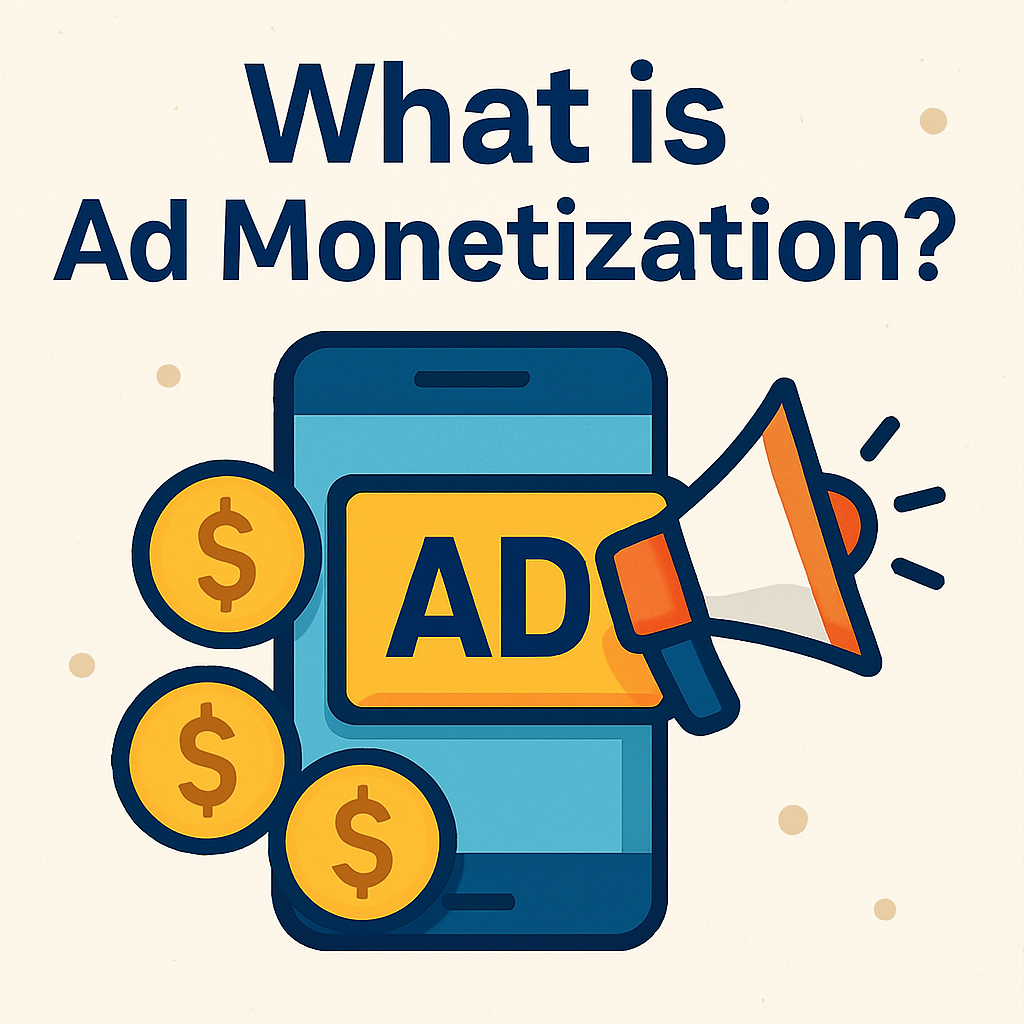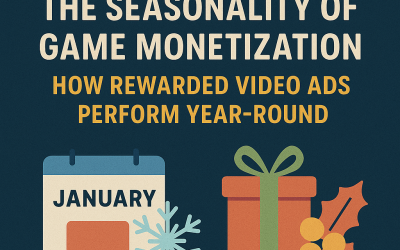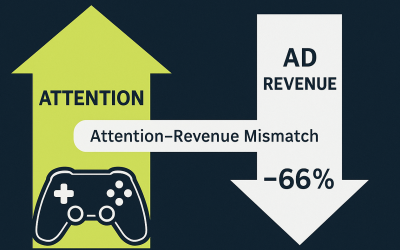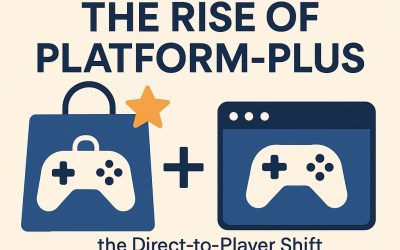What is Ad Monetization? A Complete Guide
Video games, mobile apps, and web experiences have transformed how we engage with technology. What started as simple diversions are now complex ecosystems where entertainment, education, and even productivity converge. As of 2024, the global mobile games market alone is set to reach nearly $99 billion in revenue, and it’s projected to grow to over $132 billion by 2029. This growth reveals massive opportunities—not just for large studios, but for indie developers and small teams. But how can these creators turn innovative ideas into a sustainable income stream?
The answer lies in ad monetization.
Whether you’re building a mobile game, a browser-based experience, or a full-featured app, ad monetization enables you to earn revenue while keeping your content accessible. In this comprehensive guide, we’ll explore what ad monetization is, why it matters, the different ad formats, and how to craft a winning monetization strategy that balances user satisfaction with business growth.
Contents
- 1 What Is Ad Monetization?
- 2 Why Ad Monetization Matters
- 3 Core Ad Formats Explained
- 4 Ad Monetization Payment Models
- 5 Mobile vs. Web Ad Monetization
- 6 Beyond Ads: Complementary Monetization Models
- 7 Hybrid Monetization Strategies
- 8 Planning Monetization Early
- 9 Best Practices for Ad Monetization Success
- 10 Final Thoughts: Crafting a Winning Ad Monetization Strategy
What Is Ad Monetization?
First things first on What is Ad Monetization? A Complete Guide post, Ad monetization is the process of earning revenue by displaying advertisements within your digital product—be it an app, game, or website. Instead of charging users directly for access, you allow advertisers to reach your audience through various ad formats. In return, you get paid based on how users interact with these ads.
At its simplest, this approach allows you to keep your product free, while generating income through ad impressions, clicks, or actions. This accessibility is crucial for user acquisition—especially in mobile gaming, where over 95% of downloads come from free-to-play titles.
Ad monetization models typically rely on advertising pricing metrics like:
-
CPM (Cost Per Mille): Revenue per 1,000 ad impressions.
-
CPC (Cost Per Click): Revenue per user click.
-
CPA (Cost Per Action): Revenue when users complete specific actions like installing an app.
For many developers, especially those with limited resources, ad monetization isn’t just a secondary revenue stream—it’s the foundation that supports their entire operation.
Why Ad Monetization Matters
In today’s app and gaming economy, ad monetization has become a central pillar of success for several reasons:
1. Users Expect Free Content
Data shows that most users expect to download and play games for free. Charging upfront can significantly reduce your potential user base. Ad monetization lets you reach a broader audience while still generating income.
2. It’s a Sustainable Revenue Model
Subscription fatigue is real, and in-app purchases may not always convert. Ads offer a reliable, ongoing income source that doesn’t rely solely on a small percentage of paying users.
3. It Fuels Long-Term Development
Ads can fund ongoing updates, server maintenance, customer support, and even new game development. Without ad revenue, many indie projects would struggle to sustain operations or grow.
Core Ad Formats Explained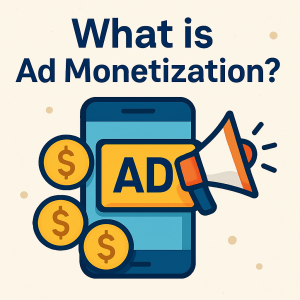
A successful ad monetization strategy starts with understanding your available tools. Different ad formats cater to different user behaviors, game genres, and revenue goals.
Rewarded Video Ads
Rewarded videos are opt-in ads where users watch a 15–30 second video in exchange for in-game benefits. These could be extra lives, bonus coins, or access to premium features.
Why they work so well? They give users a sense of control. Instead of being interrupted, they voluntarily engage—and they’re rewarded for it. For developers, rewarded ads deliver higher eCPMs due to high completion rates and positive user sentiment.
Rewarded videos are ideal at transition points—like after a level fail or before unlocking a special item.
Interstitial Ads
These full-screen ads appear between content segments, such as between game levels or during load screens. They generate higher click-through rates compared to banners, but can be intrusive if overused.
The key is to use them sparingly and only at natural breaks in gameplay. Used correctly, they offer strong returns without significantly disrupting the user experience.
Banner Ads
The most familiar ad format, banner ads are typically placed at the top or bottom of the screen. They’re static or animated images, easy to implement, and minimally invasive.
However, they often yield lower revenue per impression. Banner ads work best in casual or idle games where users spend a long time on each screen.
Offerwalls
Offerwalls present users with a catalog of tasks—like installing an app or completing a survey—in exchange for in-game currency. These are especially effective in games with economies built around premium currencies.
Offerwalls cater to users who want to unlock features or progress faster but aren’t willing to spend real money.
Native Ads
Native ads are designed to look like a part of the game or app itself. They blend seamlessly into the environment, such as in-game billboards or sponsored content cards.
These ads are ideal for developers who want to preserve immersion and avoid disrupting the user experience.
Playable Ads
Playable ads let users try out a mini-game or demo before downloading a new app. These ads are highly interactive, engaging, and particularly effective for promoting other games within the same genre.
Playable ads combine advertising with entertainment, making them a natural fit for gaming environments.
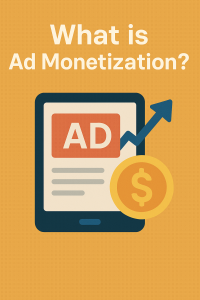 Ad Monetization Payment Models
Ad Monetization Payment Models
Following up on What is Ad Monetization? A Complete Guide post, understanding how ad revenue is calculated is crucial for maximizing returns. Here are the three most common models:
CPM (Cost Per Mille)
You get paid for every 1,000 ad impressions. This model works well for apps or games with high traffic and extended play sessions.
High CPM formats include interstitials and rewarded videos. Focus on increasing user engagement and retention to maximize views.
CPC (Cost Per Click)
You earn only when a user clicks an ad. CPC models favor apps with high engagement and curiosity-driven users. Placement is critical—ads must be visible but not misleading.
CPA (Cost Per Action)
You earn when a user completes a specific action, such as installing another app or signing up for a service. This model is ideal for offerwalls and interactive ad units where conversion is the goal.
Mobile vs. Web Ad Monetization
While ad monetization principles are platform-agnostic, implementation differs between mobile and web.
Mobile Games
Mobile ad networks like Unity Ads, AdMob, and ironSource offer robust SDKs tailored for mobile environments. Players are familiar with ad placements like rewarded videos, making monetization feel natural.
These platforms also support detailed analytics, segmentation, and A/B testing—crucial for optimizing performance.
Web Games and Apps
Web-based experiences—especially HTML5 games—are a rapidly growing space for monetization. Platforms like AppLixir allow developers to integrate rewarded videos and display ads directly into their games without disrupting performance or user flow.
Web users expect instant play and minimal friction. This makes non-intrusive, opt-in ad formats essential for maintaining engagement and retention.
Beyond Ads: Complementary Monetization Models
Before finalizing What is Ad Monetization? A Complete Guide post, to maximize revenue and user satisfaction, consider supplementing ads with additional monetization strategies.
In-App Purchases (IAP)
IAPs allow users to buy items like consumables (e.g., coins, energy), non-consumables (e.g., character skins), or upgrades. They serve users who are highly engaged and willing to spend money on customization or progress acceleration.
Subscriptions
Subscriptions provide ongoing access to premium content for a monthly or yearly fee. Models like ad removal, battle passes, or VIP memberships can provide consistent revenue from loyal users.
Subscriptions are especially effective in games with frequent updates, evolving content, or strong community elements.
Hybrid Monetization Strategies
Many of the most successful games today combine multiple monetization models. This allows you to monetize different segments of your audience in different ways.
Ads + In-App Purchases
This combination monetizes both casual and invested players. Casual players engage with ads to earn currency, while core players make direct purchases.
Care must be taken not to alienate paying users with too many ads. Often, purchases also unlock an ad-free experience.
IAP + Subscriptions
This pairing offers flexibility. Subscriptions provide stability, while IAPs capture one-time spending behavior. Games with strong social or competitive elements benefit most.
Ads + IAP + Subscriptions
The most comprehensive strategy, this hybrid model allows you to serve the widest audience. However, it requires careful balancing, thoughtful UX design, and continual A/B testing to ensure users feel valued—not exploited.
Planning Monetization Early
Monetization shouldn’t be an afterthought. Designing your monetization strategy early in development leads to a more seamless integration.
Early planning lets you:
-
Align gameplay loops with monetization opportunities
-
Test ad placements and reward values during development
-
Avoid last-minute SDK integrations that can disrupt performance
Games that bake in monetization from the start are better at balancing revenue with user experience.
Best Practices for Ad Monetization Success
To get the most out of your ad strategy, follow these industry-proven best practices:
1. Respect the Player
Users should feel in control. Rewarded videos should always be opt-in, and interstitials should appear only at natural breaks. Ads that interrupt gameplay without warning lead to user frustration and churn.
2. Optimize Ad Placement
Strategic ad placement enhances performance. Place banner ads where users won’t accidentally tap. Insert rewarded videos at high-emotion moments like just before a level retry.
3. A/B Test Everything
There’s no single formula for success. Test different ad networks, reward values, ad frequencies, and placements to see what resonates with your audience.
4. Use Analytics to Guide Decisions
Track metrics like eCPM, CTR, ARPDAU, and retention. A dip in retention might indicate ad fatigue, while a spike in CPM could reveal a high-performing ad placement.
5. Personalize When Possible
User segmentation allows you to tailor the ad experience. Casual players might tolerate more ads. Hardcore users may prefer a subscription or ad-free tier.
Final Thoughts: Crafting a Winning Ad Monetization Strategy
There’s no one-size-fits-all approach to ad monetization. The ideal strategy depends on your app’s genre, audience behavior, and long-term goals. What’s universal, however, is the importance of planning, testing, and respecting the user experience.
A well-executed ad monetization model doesn’t just generate revenue. It creates a balanced ecosystem where:
-
Users enjoy free, valuable content
-
Developers fund their vision
-
Advertisers reach engaged, relevant audiences
By combining ad formats, exploring hybrid models, and planning from the ground up, you can create a sustainable monetization strategy that powers growth and innovation.
